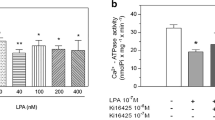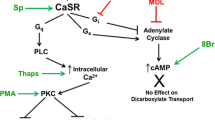Summary
Eleven different secosteroids or steroids (10−10 to 10−8 m) were acutely and reversibly introduced in solutions delivered to the lumen of single proximal tubules of the amphibianNecturus kidney while recording basolateral cell membrane potentialV m. Seven of these molecules (1,25(OH)2D3, 25(OH)D3, 24,25(OH)2D3, 5,6-trans-25(OH)D3, 19-diol-cholesterol, estradiol and testosterone) resulted in changes ofV m (ΔV m) occurring in a few seconds, the largest ΔV m being observed with 1,25(OH)2D3, +6.5±0.75 mV (n=19); these seven (seco)steroids but not the four inactive sterols (vitamin D3, cholesterol, 1αD3 and aldosterone) possess a hydroxyl group on at least one carbon of the C17 to C25 lateral chain of the sterol ring. The ΔV m effect was present in Na+-free or Cl−-free media, but it was abolished in HCO3-free media. Depolarization of cell membrane potential by addition of glucose, 11mm, in luminal perfusion fluid abolished the 1,25(OH)2D3-evoked ΔV m effect, suggesting dependence of the latter on the absolute value of membrane potential. Barium, a blocking agent of K+ conductances, suppressed the 1,25(OH)2D3-evoked ΔV m effect, even when the proper effects of barium of cell membrane potential were canceled by current clamp. Pretreatment with quinine, a putative blocker of Ca2+-dependent K+ channels also abolished the 1,25(OH)2D3-evoked depolarization. Such observations are consistent with the presence of Ca2+-dependent K+ channels at the apical cell membrane of the proximal tubule, these channels being inactivated by 1,25(OH)2D3 and probably by other (seco)steroids.
Similar content being viewed by others
References
Anagnostopoulos, T. 1973. Biionic potentials in the proximal tubule ofNecturus kidney.J. Physiol. (London) 233:375–394
Anagnostopoulos, T. 1975. Anion permeation in the proximal tubule ofNecturus kidney: The shunt pathway.J. Membrane Biol. 24:365
Anagnostopoulos, T. 1981. Electrophysiology of the nephron.In: Proc. 8th Int. Congr. Nephrol.. W. Zurukzoglu, M. Papadimitriou, M. Pyrpasopoulos, M. Sion & C. Zamboulis, editors. pp. 39–45. S. Karger, Basel
Anagnostopoulos, T., Edelman, A. 1977. Electrophysiological study of bicarbonate effects on antiluminal membrane at the proximal tubule ofNecturus kidney.J. Physiol. (London) 266:40P-41P
Bello-Reuss, E. 1982. Electrical properties of the basolateral membrane of the straight portion of the rabbit proximal renal tubule.J. Physiol. (London) 326:49–63
Burckhardt, B.C., Sato, K., Frömter, E. 1984. Electrophysiological analysis of bicarbonate permeation across the peritubular cell membrane of rat kidney proximal tubule. I. Basic observations.Pfluegers Arch. 401:34–42
Burges, G.M., Claret, M., Jenkinson, D.H. 1981. Effects of quinine and apamin on the calcium dependent potassium permeability of mammalian hepatocytes and red cells.J. Physiol. (London) 317:67–90
Cook, N.S., Haylett, D.G. 1985. Effects of apamin, quinine and neuromuscular blockers on calcium-activated potassium channels in guinea-pig hepatocytes.J. Physiol. (London) 358:373–394
Dufy, B., Vincent, J.D., Fleury, H., Du Pasquier, P., Gourdji, D., Tixier-Vidal, A. 1979. Membrane effects of thyrotropin-releasing hormone and estrogen shown by intracellular recording by pituitary cells.Science 204:509–511
Duval, D., Durant, S., Homo-Delarche, F. 1983. Non-genomic effects of steroids. Interactions of steroid molecules with membrane structures and functions.Biochim. Biophys. Acta 737:409–442
Edelman, A., Anagnostopoulos, T. 1978. Further studies of ion permeation in proximal tubule ofNecturus kidney.Am. J. Physiol. 235:F89
Edelman, A., Bouthier, M., Anagnostopoulos, T. 1981. Chloride distribution in the proximal convoluted tubule ofNecturus kidney.J. Membrane Biol. 62:7–17
Edelman, A., Teulon, J., Anagnostopoulos, T. 1983. Peculiarities of the Na+/d-glucose cotransport system inNecturus renal tubules.Biochim. Biophys. Acta 731:211–216
Edelman, A., Thil, C.L., Garabedian, M., Anagnostopoulos, T., Balsan, S. 1983. Genome-independent effects of 1,25-dihydroxyvitamin D3 on membrane potential.Biochim. Biophys. Acta 732:300–303
Edelman, A., Thil, C.L., Garabedian, M., Plachot, J.J., Guillozo, H., Fritsch, J., Thomas, S.R., Balsan, S. 1985. Vitamin D metabolite effects on membrane potential and potassium intracellular activity in rabbit cartilage.Mineral Electrolyte Metab. 11:97–105
Greger, R., Schlatter, E. 1983. Properties of the lumen membrane of the cortical thick ascending limb of Henle's loop of rabbit kidney.Pfluegers Arch. 396:315
Hille, B., Woodhull, A.M., Shapiro, B.I. 1975. Negative surface charge near sodium channels of nerve: Divalent ions, monovalent ions, and pH.Philos. Trans. R. Soc. London B 270:301–318
Kubota, T., Biagi, B.A., Giebisch, G. 1983. Effects of acidbase disturbance on the basolateral membrane potential and intracellular potassium activity in the proximal tubule ofNecturus.J. Membrane Biol. 73:61–68
O'Neil, R., Sansom, S. 1984. Characterization of apical cell membrane Na+ and K+ conductances of cortical collecting duct using microelectrode techniques.Am. J. Physiol. 247:F14-F24
Petersen, O.H., Maruyama, Y. 1984. Calcium-activated potassium channels and their role in secretion.Nature (London) 307:693
Planelles, G., Kurkdjian, A., Anagnostopoulos, T. 1984. Cell and luminal pH in the proximal tubule ofNecturus kidney.Am. J. Physiol. 247:F932-F938
Planelles, G., Teulon, J., Anagnostopoulos, T. 1981. The effects of barium on the electrical properties of the basolateral membrane in proximal tubule.Naunyn Schmiedeberg's Arch. Pharmacol. 318:135–141
Preece, M.A., O'Riordan, J.L.H., Lawson, D.E.M., Kodicek, E. 1974. A competitive protein binding assay for 25(OH)D3 and 25-hydroxyergocalciferol in serum.Clin. Chim. Acta 54:235
Shepard, R.M., Horst, R.L., Hamstra, A.J., Deluca, H.F. 1979. Determination of vitamin D metabolites in plasma from normal and anephric man.Biochem. J. 182:55
Van Driessche, W., Zeiske, W. 1982. Cation selective channels in the apical membrane of frog skin unmasked by decreasing external [Ca2+] and intracellular [H+].Arch. Int. Physiol. Biochim. 90:P94-P95
Wasserman, R.H., Fullmer, C.S. 1983. Calcium transport protein, calcium absorption, and vitamin D.Annu. Rev. Physiol. 45:375–390
Willmer, E.N. 1961. Steroids and cell surfaces.Biol. Rev. 36:368–398
Author information
Authors and Affiliations
Rights and permissions
About this article
Cite this article
Edelman, A., Garabedian, M. & Anagnostopoulos, T. Mechanisms of 1,25(OH)2D3-induced rapid changes of membrane potential in proximal tubule: Role of Ca2+-dependent K+ channels. J. Membrain Biol. 90, 137–143 (1986). https://doi.org/10.1007/BF01869931
Received:
Revised:
Issue Date:
DOI: https://doi.org/10.1007/BF01869931




